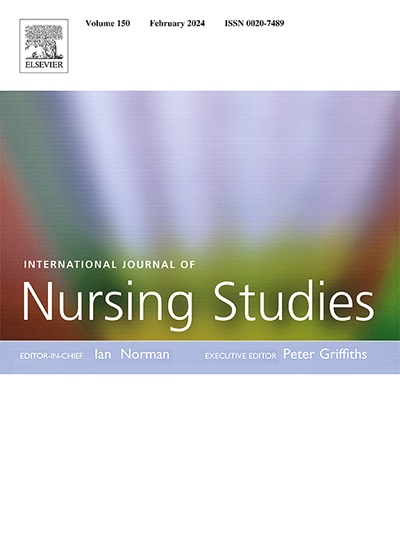园艺活动对减轻社区成人抑郁症状的影响:一项系统回顾和荟萃分析
IF 7.1
1区 医学
Q1 NURSING
引用次数: 0
摘要
目的回顾分析园艺活动对社区居民抑郁症状缓解效果的随机对照试验和临床对照试验。入选标准包括将抑郁症状作为结果的随机对照试验和对照临床试验。只包括居住在社区的成年人。所涉及的干预措施是与真实植物直接互动的园艺活动。排除的干预措施包括完全基于虚拟现实的干预措施和被动参与自然环境。比较组不能包括任何园艺元素。数据来源于12/9/2024检索了14个数据库:Academic Search Ultimate、APA PsycInfo、British Nursing Index、CINAHL、CENTRAL、Educational Resources Information Center、Embase、Epistemonikos、Global Health、MEDLINE、Ovid Emcare、Ovid Nursing Database、Scopus、Web of Science。进行引文检索。偏倚风险使用了偏倚风险-2和非随机干预研究中的偏倚风险工具。数据采用随机效应荟萃分析模型进行综合。效应量以标准化平均差异估计。结果本系统综述纳入了30项研究和2071名参与者。荟萃分析涵盖了25项研究,并表明园艺活动对抑郁症状的总体影响中等(SMD为- 0.67,95% CI为- 0.86至- 0.47,I2 54%)。亚组分析显示,园艺疗法和治疗性园艺在效果上没有显著差异(园艺疗法:SMD为- 0.74,95% CI为- 1.35 ~ - 0.14,i279%;治疗园艺:SMD为- 0.62,95% CI为- 0.80至- 0.45,I2为27%)。在年轻人和老年人中,园艺活动减轻抑郁症状的效果中等(SMD为- 0.59,95% CI为- 0.83至- 0.36,I2 43%), SMD为- 0.73,95% CI为- 1.05至- 0.40,I2为61%)。室内和室外干预无显著差异(室内:SMD = - 0.55, 95% Cl = - 0.87 ~ - 0.23, I2 = 61%;户外:SMD−0.62,95% Cl−0.83−0.42,I2 6%)。每周一次干预的效果(SMD为- 0.61,95% Cl - 0.92至- 0.30,I2 68%)与每周一次干预的效果相似(SMD为- 0.72,95% Cl - 1.05至- 0.39,I2为37%)。园艺活动的有效组成部分包括植物护理、园艺艺术品、收获、食物消费、感官刺激和开始仪式。由于伦理要求和干预性质,大多数研究存在较高的偏倚风险。这篇综述表明,抑郁症状可以通过园艺活动减轻,如植物护理、园艺艺术品、收获、食物消费、感官刺激和开始仪式。实施每周园艺活动,以较少的时间投入达到干预效果最好。本文章由计算机程序翻译,如有差异,请以英文原文为准。
Effect of horticultural activities on reducing depressive symptoms in community-dwelling adults: a systematic review and meta-analysis
Objective
To review and analyse randomised-controlled trials and controlled clinical trials on the effect of horticultural activities on alleviating depressive symptoms in community-dwelling adults.
Eligibility criteria
We included randomised controlled trials and controlled clinical trials that reported depressive symptoms as an outcome. Only community-dwelling adults are included. Involved interventions were horticultural activities with direct interactions with real plants. Excluded interventions include complete virtual-reality-based interventions and passive involvement in a natural environment. The comparison group must not include any horticultural elements.
Data sources
On 12/9/2024, 14 databases were searched: Academic Search Ultimate, APA PsycInfo, British Nursing Index, CINAHL, CENTRAL, Educational Resources Information Center, Embase, Epistemonikos, Global Health, MEDLINE, Ovid Emcare, Ovid Nursing Database, Scopus, and Web of Science. Citation Search was performed.
Risk of bias
The Risk of Bias-2 and the Risk-Of-Bias In Non-randomised Studies-of-Interventions tool were utilised.
Result synthesis
Data was synthesised using a random-effects meta-analyses model. Effect sizes were estimated as standardised mean differences.
Results
The systematic review covered 30 studies and 2071 participants. The meta-analysis covered 25 studies and indicated that horticultural activities had an overall moderate effect on depressive symptoms (SMD − 0.67, 95 % CI − 0.86 to − 0.47, I2 54 %). Subgroup analyses revealed that horticultural therapy and therapeutic horticulture had no significant difference in effects (horticultural therapy: SMD − 0.74, 95 % CI − 1.35 to − 0.14, I2 79 %; therapeutic horticulture: SMD − 0.62, 95 % CI − 0.80 to − 0.45, I2 27 %). The effect of horticultural activities in reducing depressive symptoms was moderate among younger adults (SMD − 0.59, 95 % CI − 0.83 to − 0.36, I2 43 %), and older adults (SMD − 0.73, 95 % CI − 1.05 to − 0.40, I2 61 %). The interventions conducted indoors and outdoors showed no significant difference (Indoor: SMD −0.55, 95 % Cl − 0.87 to − 0.23, I2 61 %; Outdoor: SMD − 0.62, 95 % Cl − 0.83 to − 0.42, I2 6 %). The effects of interventions once a week (SMD − 0.61, 95 % Cl − 0.92 to − 0.30, I2 68 %) were similar to those twice a week (SMD − 0.72, 95 % Cl − 1.05 to − 0.39, I2 37 %). The effective components of horticultural activities included plant care, horticultural artwork, harvesting, food consumption, sensory stimulation, and starting rituals.
Discussion
Most studies have high risk of bias due to ethical requirements and the intervention nature. This review shows that depressive symptoms can be reduced through horticultural activities, such as plant care, horticultural artwork, harvesting, food consumption, sensory stimulation, and starting rituals. Implementing weekly horticultural activities can best achieve intervention results with less time investment.
求助全文
通过发布文献求助,成功后即可免费获取论文全文。
去求助
来源期刊
CiteScore
15.00
自引率
2.50%
发文量
181
审稿时长
21 days
期刊介绍:
The International Journal of Nursing Studies (IJNS) is a highly respected journal that has been publishing original peer-reviewed articles since 1963. It provides a forum for original research and scholarship about health care delivery, organisation, management, workforce, policy, and research methods relevant to nursing, midwifery, and other health related professions. The journal aims to support evidence informed policy and practice by publishing research, systematic and other scholarly reviews, critical discussion, and commentary of the highest standard. The IJNS is indexed in major databases including PubMed, Medline, Thomson Reuters - Science Citation Index, Scopus, Thomson Reuters - Social Science Citation Index, CINAHL, and the BNI (British Nursing Index).

 求助内容:
求助内容: 应助结果提醒方式:
应助结果提醒方式:


